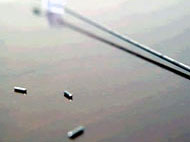Hospital Urology Procedures
Learn About a Hospital Urology Procedure

Male & Female Incontinence Management (including Bladder Pacemaker)
InterStim Therapy uses a small device to send mild electrical pulses to a nerve located in the lower back (just above the tailbone). This nerve, called the sacral nerve, influences the bladder and surrounding muscles that manage urinary function. The electrical stimulation may eliminate or reduce certain bladder control symptoms in some people. The system is surgically placed under the skin.
Dr. Razi has been performing this procedure both in the office and in the hospital for a number of years, with overwhelming success.
For more information, please visit:
(209) 833-3449 Request an Appointment
Brachytherapy for Prostate Cancer
There are two approaches to brachytherapy for prostate cancer:
- Low-dose rate (LDR) prostate brachytherapy. This is the most commonly performed technique. With LDR brachytherapy, the seeds are permanently placed into the prostate. The radiation is given off gradually over a period of months.
-

Brachytherapy – Hospital Urological Procedure – Tracy and Manteca
An ultrasound study may be performed prior to the day of the procedure to ensure there are no bones interfering with the placement of needles into the prostate. The ultrasound probe is placed into the rectum to obtain pictures of the prostate and surrounding structures. This study is commonly referred to as a transrectal ultrasound (TRUS). The information obtained from the TRUS can also be used to generate a road map for seed implantation. Ultrasound imaging is typically used to define the prostate although newer approaches using CT scan or MRI may be used.
The LDR seed implant procedure is performed under anesthesia. Radioactive seeds (which are smaller than a grain of rice) are loaded in individual needles that are passed into the prostate gland through the skin between the scrotum and anus. As the needles penetrate the prostate they are seen on a monitor and can be accurately guided to their predetermined position. Once the position of the needle in the prostate matches the intended position the needle is withdrawn leaving the seeds behind in the prostate. The radioactivity of the seeds slowly decays during the months after the operation, and there are few long-term risks associated with this treatment.
Alternatively, HDR brachytherapy may be utilized to place a highly radioactive source temporarily into the prostate. Hollow plastic tubes called catheters are pre-positioned in the prostate using a technique similar to LDR brachytherapy. The patient is then awakened and typically two or three treatments are given over the next several days after which the catheters are removed. A remote control device is used to move the radioactive material, which rests for a calculated period of time at various positions within each catheter. A computerized treatment-planning program is used to determine the required time the radioactive material must stay at each position and the sequential positioning of the radioactive material at each location needed to achieve coverage of the prostate with the prescribed radiation dose.
(209) 833-3449 Request an Appointment
Laser Treatments for Kidney Stones

Laser Treatments for Kidney Stones – Hospital Procedure – Tracy and Manteca
(209) 833-3449 Request an Appointment
Oncology Surgeries
(209) 833-3449 Request an Appointment
